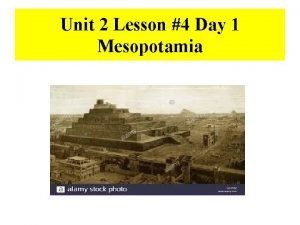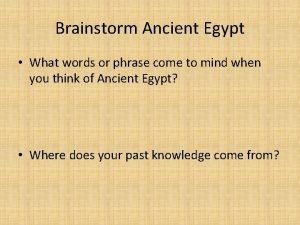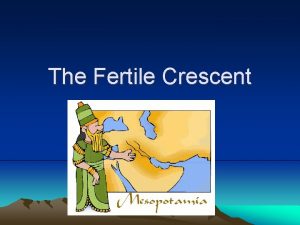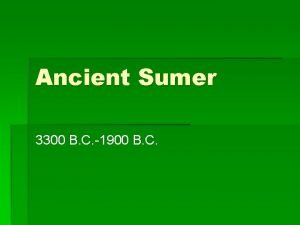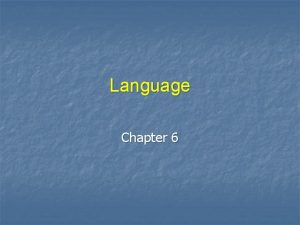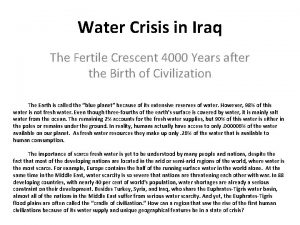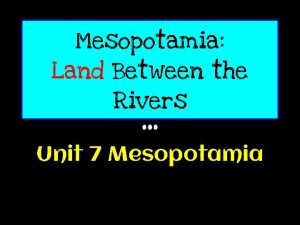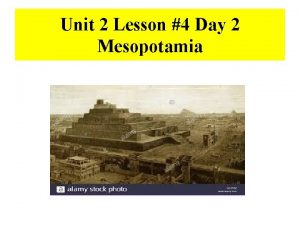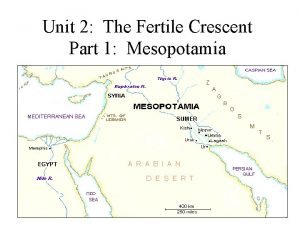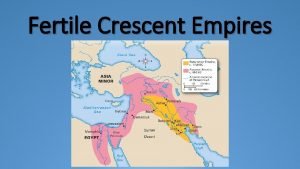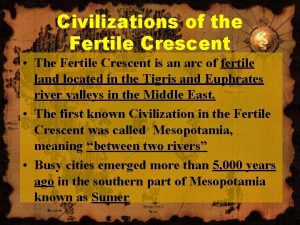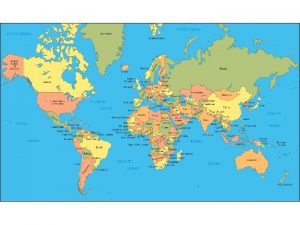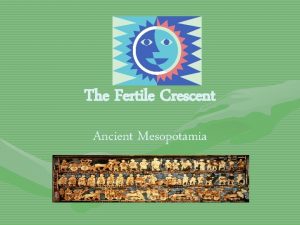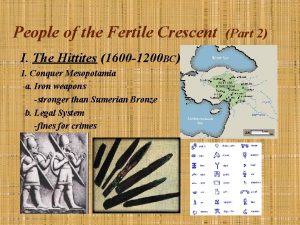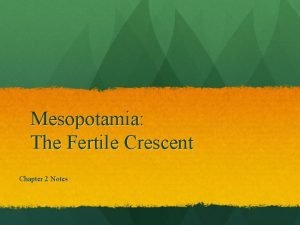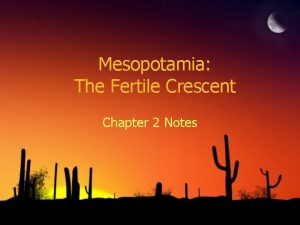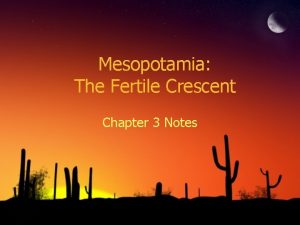The Fertile Crescent Empires The Hittites As the



















- Slides: 19

The Fertile Crescent Empires: The Hittites As the Babylonian Empire Declined, other civilizations prospered around the Fertile Crescent Nomadic tribes from the mountains and deserts moved into the region as well Tribes battled each other for land Power and control passed from one group to the next

Indo-Europeans The Indo-Europeans were one of the tribes who invaded Mesopotamia Each of these tribes spoke a related language Indo-Europeans came from the Steppes, or grasslands north of the Black Sea. They left the area because of possible drought, social conflict, or lack of resources

Hittite Military The Hittites were a warlike Indo. European tribe They settled in Asia Minor (modern day Turkey) around 2000 BCE They conquered the area and created a strong empire

Why was their Military successful? Horse-drawn war chariot; it was heavy and slow, but powerful At that time most chariots only had two soldiers, but the Hittites held three soldiers (i. e. , one man drove, a second fought, and a third held shields) This allowed them to get closer in battle This allowed them to expand their empire beyond Asia Minor In 1595 BCE, they destroyed Babylon fell to the Kassites, who ruled the area for nearly 400 years

Hittite Culture The Hittites, much like the Akkadians and Babylonians, blended their culture with the cultures around them (Assimilation) They used Sumerian Cuneiform to write their language Developed a code very similar to Hammurabi’s code

Hittite Contributions First people to master iron working techniques – eventually turned into Iron tools and weapons Hittite rule reached its peak around 1300 BCE, and stuck around until 1200 BCE Their empire fell to powerful raiders, known as the “Sea Peoples”

The Assyrians and the Chaldeans After the Hittite Empire fell, other peoples fought for dominance in western Asia Eventually the Assyrians emerged as a power

The Assyrians Originally from northern Mesopotamia, near the city of Assur along the upper Tigris River Grew barley and raised cattle Adopted much of Sumerian culture Assyrians’ land received fairly good rainfall and was in the midst of major trade routes – this caused many tribes to invade as an attempt to control the area The Assyrians briefly gained power in the 1300 s BCE and built an empire but it didn’t last Then again in 900 BCE the Assyrians regained strength and built a new empire (included Mesopotamia, Asia minor, and Egypt)

Assyrian Empire: Map

The Assyrians: Military Machine Assyria’s power relied on its military (because of their location, frequent rain, and fertile soil) Constant warfare turned them into a warrior society Their army included chariots, foot soldiers, and cavalry – all had iron weapons SIEGE WARFARE, AND TERROR!!!!!

Assyrian Rule Kings ruled through local leaders, each of whom governed a small area of the empire Local leader collected taxes, enforced laws, and raised troops for the army A system of roads linked the distant parts of the empire Messengers and merchants traveled these roads To maintain peace, the Assyrians punished anyone who opposed them.

Assyrian Achievements Library of Nineveh, which had more than 20, 000 cuneiform tablets, which were collected across the empire – one being the Epic of Gilgamesh

Assyrian decline As the empire grew larger, it became harder to control The Chaldeans and the Medes saw an opportunity and joined forces In 612 BCE, they captured and burned their capital, Nineveh The Assyrian empire came to an end

The Chaldeans As Assyrian was destroyed, the Chaldeans picked up the pieces The Chaldeans formed their own empire The Chaldeans made the old City of Babylon the capital of their new Babylonian empire Nebuchadnezzar II was the most famous Chaldean king

Nebuchadnezzar II Most famous Warrior and builder Fought the Egyptians the Jews Took Jerusalem Rebuilt Babylon Architecture was believed to be amazing The grand palace was where the Hanging Gardens were believed to be

Chaldean Culture Admired ancient Sumerian culture, studied Sumerian language, and built temples to Sumerian gods The Chaldeans developed a calendar based on the phases of the moon Chaldeans were short lived In 539 BCE, less than a century later, the Persians conquered Babylon and the Chaldean Empire ended

Growth of a Trading Society Phoenicia is located on the western end of the Fertile Crescent (today’s Lebanon) Geographic makeup - narrow coastal plain, rugged hills and mountains Farming was difficult and resources were limited Turned to the sea and became excellent sailors and dominated trade in the Mediterranean and sailing to ports in Egypt, Greece, Italy, Sicily, and Spain As trade grew, they founded colonies along their trade routes Carthage – was one of the most famous Phoenician colonies, which later becomes quite powerful

The Phoenicians Small city-states like Sidon and Tyre emerged as trading cities Although they were usually under a foreign empire, they became quite wealthy

The Phoenician Alphabet One of the first alphabets 22 letters, all consonants This made writing easier Greeks borrowed and modified it
 Unit 2 lesson 4 fertile crescent
Unit 2 lesson 4 fertile crescent Middle east map
Middle east map Hyksos invasion of egypt
Hyksos invasion of egypt Geography of the fertile crescent
Geography of the fertile crescent Fertile crescent on world map
Fertile crescent on world map Geography of the fertile crescent
Geography of the fertile crescent The fertile crescent is the arc of land that
The fertile crescent is the arc of land that Mesopotamia environmental challenges
Mesopotamia environmental challenges Geography of the fertile crescent
Geography of the fertile crescent Agricultural hearths
Agricultural hearths Geography of the fertile crescent
Geography of the fertile crescent Multilingual state
Multilingual state Where's the fertile crescent
Where's the fertile crescent Mesopotamia land between two rivers
Mesopotamia land between two rivers Unit 2 lesson 4 fertile crescent
Unit 2 lesson 4 fertile crescent Fertile crescent
Fertile crescent Fertile crescent
Fertile crescent Fertile crescent
Fertile crescent Fertile crescent
Fertile crescent Maritime and land based empires
Maritime and land based empires
